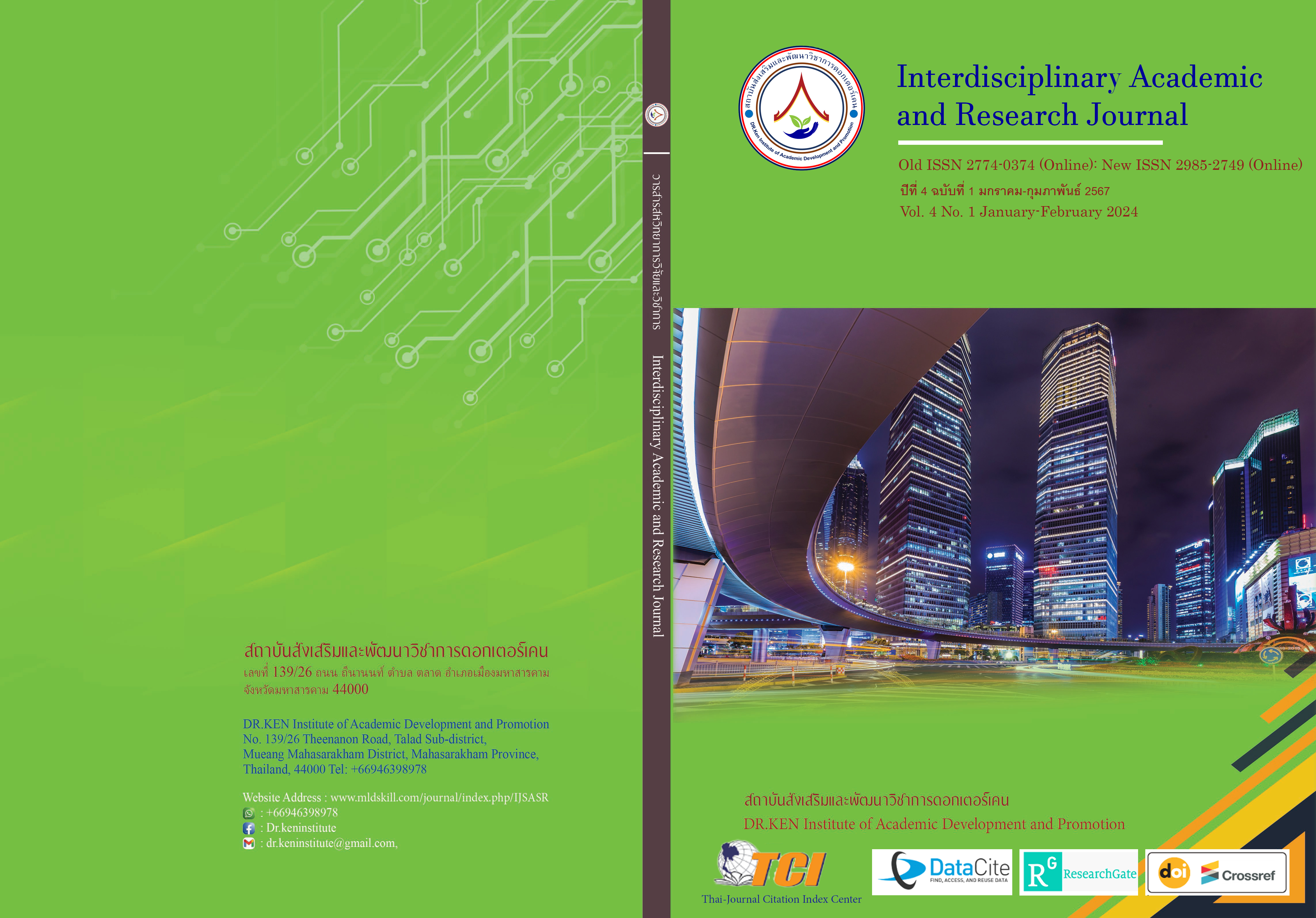ผลของการฝึกแบบสถานีด้วยแรงต้านในสภาวะปริมาณออกซิเจนต่ำที่มีต่อสมรรถภาพด้านแอโรบิก
DOI:
https://doi.org/10.60027/iarj.2024.273539คำสำคัญ:
การฝึกแบบสถานีด้วยแรงต้าน; , สภาวะปริมาณออกซิเจนต่ำ; , สมรรถภาพด้านแอโรบิกบทคัดย่อ
การสร้างเสริมและพัฒนาสมรรถภาพทางกายเป็นพื้นฐานสำคัญและมีความจำเป็นอย่างยิ่งสำหรับนักกีฬาทุกประเภท เพราะนอกจากจะทำให้ระดับสมรรถภาพทางกายของนักกีฬาเพิ่มสูงขึ้นแล้ว ยังส่งผลดีให้เกิดการเคลื่อนไหวและการปฏิบัติทักษะกีฬาได้อย่างมีประสิทธิภาพ ดังนั้นการวิจัยครั้งนี้มีวัตถุประสงค์ (1) เพื่อเปรียบเทียบผลของการฝึกแบบสถานีด้วยแรงต้านในสภาวะปริมาณออกซิเจนต่ำ และสภาวะปริมาณออกซิเจนปกติที่มีต่อสมรรถภาพด้านแอโรบิก (2) เพื่อเปรียบเทียบผลของการฝึกแบบสถานีด้วยแรงต้านในสภาวะปริมาณออกซิเจนต่ำที่มีต่อสมรรถภาพด้านแอโรบิก ก่อนการฝึก หลังการฝึกสัปดาห์ที่ 4 และหลังการฝึกสัปดาห์ที่ 8 และ (3) เพื่อเปรียบเทียบผลของการฝึกแบบสถานีด้วยแรงต้านในสภาวะปริมาณออกซิเจนปกติที่มีต่อสมรรถภาพด้านแอโรบิก ก่อนการฝึก หลังการฝึกสัปดาห์ที่ 4 และหลังการฝึกสัปดาห์ที่ 8
ระเบียบวิธีการวิยจัย: กลุ่มตัวอย่างเป็นนักกีฬาที่มีการแข่งขันแบบหนักสลับพัก ได้แก่ ฟุตซอล บาสเกตบอล และแฮนด์บอล เพศชาย อายุระหว่าง 18 - 22 ปี คัดเลือกด้วยวิธีการสุ่มแบบหลายขั้นตอน จำนวน 24 คน แบ่งออกเป็น 2 กลุ่ม กลุ่มละ 12 คน คือ กลุ่มทดลองที่ 1 และกลุ่มทดลองที่ 2 ฝึกตามโปรแกรมที่กำหนด 8 สัปดาห์ กลุ่มละ 3 วัน การวิเคราะห์ข้อมูลใช้สถิติเชิงพรรณนา คือ ค่าเฉลี่ย ค่าเบี่ยงเบนมาตรฐาน และสถิติเพื่อการทดสอบสมมติฐานการวิจัย คือ การวิเคราะห์ความแปรปรวนพหุคูณแบบวัดซ้ำ นัยสำคัญทางสถิติกำหนดไว้ที่ .05
ผลการวิจัย: (1) สมรรถภาพด้านแอโรบิกของกลุ่มที่ฝึกแบบสถานีด้วยแรงต้านในสภาวะปริมาณออซิเจนต่ำ และกลุ่มที่ฝึกแบบสถานีด้วยแรงต้านในสภาวะออกซิเจนปกติ ไม่แตกต่างกันอย่างมีนัยสำคัญทางสถิติ (2) กลุ่มที่ทำการฝึกแบบสถานีด้วยแรงต้านในสภาวะปริมาณออกซิเจนต่ำ มีค่าความสามารถสูงสุดในการนำออกซิเจนเข้าสู่ร่างกาย ก่อนการฝึก หลังการฝึกสัปดาห์ที่ 4 และหลังการฝึกสัปดาห์ที่ 8 แตกต่างกันอย่างมีนัยสำคัญทางสถิติ ในขณะที่จุดเริ่มล้าก่อนการฝึก และหลังการฝึกสัปดาห์ที่ 4 แตกต่างกับหลังการฝึกสัปดาห์ที่ 8 อย่างมีนัยสำคัญทางสถิติ และ (3) กลุ่มที่ทำการฝึกแบบสถานีด้วยแรงต้านในสภาวะปริมาณออกซิเจนปกติ มีค่าความสามารถสูงสุดในการนำออกซิเจนเข้าสู่ร่างกาย และจุดเริ่มล้าก่อนการฝึก และหลังการฝึกสัปดาห์ที่ 4 แตกต่างกับหลังการฝึกสัปดาห์ที่ 8 อย่างมีนัยสำคัญทางสถิติ
สรุปผล: การฝึกแบบสถานีด้วยแรงต้านในสภาวะปริมาณออกซิเจนต่ำ และสภาวะปริมาณออกซิเจนปกติ สามารถพัฒนาสมรรถภาพด้านแอโรบิกได้เท่าเทียมกัน
References
Albertus-Cámara, I., Ferrer-López, V., & Martínez-González-Moro, I. (2022). The effect of normobaric hypoxia in middle-and/or long-distance runners: Systematic review. Biology, 11(5), 689.
Ballesta-García, I., Martínez-González-Moro, I., Ramos-Campo, D.J., & Carrasco-Poyatos, M. (2020). High-intensity interval circuit training versus moderate-intensity continuous training on cardiorespiratory fitness in middle-aged and older women: A randomized controlled trial. International Journal of Environmental Research and Public Health, 17(5), 1805.
Birkett, S.T., Nichols, S., Sawrey, R., Gleadall-Siddall, D., McGregor, G., & Ingle, L. (2019). The effects of low-volume high-intensity interval training and circuit training on maximal oxygen uptake. Sport Sciences for Health, 15, 443-451.
Blumenthal, J.A., Babyak, M.A., Moore, K.A., Craighead, W.E., Herman, S., Khatri, P., & Krishnan, K.R. (1999). Effects of exercise training on older patients with major depression. Archives of Internal Medicine, 159(19), 2349-2356.
Bompa, T., & Buzzichelli, C. (2015). Periodization Training for Sports. 3rd edition, Champaign, IL: Human kinetics.
Cohen, J. (1977). Statistical Power Analysis for Behavioral Sciences. New York: Academic Press.
Craft, L. L., & Perna, F. M. (2004). The benefits of exercise for the clinically depressed. The Primary Care Companion to the Journal of Clinical Psychiatry, 6(3), 104.
Donnelly, J. E., Blair, S. N., Jakicic, J. M., Manore, M. M., Rankin, J. W., & Smith, B. K. (2009). American College of Sports Medicine Position Stand. Appropriate physical activity intervention strategies for weight loss and prevention of weight regain for adults. Medicine and Science in Sports and Exercise, 41(2), 459-471.
Eroğlu, A., & Aydın, T. (2021). Effect of intermittent hypoxic intervention on aerobic and anaerobic performance of the elite athletes. Medical Science and Discovery, 8(8), 460-464.
Garber, C.E., Blissmer, B., Deschenes, M.R., Franklin, B.A., Lamonte, M. J., Lee, I.M., & Swain, D.P. (2011). American College of Sports Medicine position stand. Quantity and quality of exercise for developing and maintaining cardiorespiratory, musculoskeletal, and neuromotor fitness in apparently healthy adults: guidance for prescribing exercise. Medicine and Science in Sports and Exercise, 43(7), 1334-1359.
Guardado, I., Ureña, B., Cardenosa, A., Cardenosa, M., Camacho, G., & Andrada, R. (2020). Effects of strength training under hypoxic conditions on muscle performance, body composition, and hematological variables. Biology of Sport, 37(2), 121-129.
Henderson, M.J., Grandou, C., Chrismas, B.C.R., Coutts, A.J., Impellizzeri, F.M., & Taylor, L. (2023). Core body temperatures in intermittent sports: A systematic review. Sports Medicine, 53(11), 2147-2170.
Islam, H., Bonafiglia, J.T., Granata, C., & Gurd, B. J. (2020). Exercise-induced mitochondrial biogenesis: Molecular regulation, impact of training, and influence on exercise performance. In: Tiidus, P. M., MacPherson, R.E.K., LeBlanc, P.J., Josse, A.R., editors. The Routledge Handbook on Biochemistry of Exercise, 143-161.
Jatra, R., Wati, S.Z., Kumara, A.R., Rinaldi, M.W., & Fernado, R. (2023). The effect of circuit training on improvement in futsal athletes: Literature review. JOURNAL RESPECS (Research Physical Education and Sports), 5(1), 44-48.
Kenney, W.L., Wilmore, J.H., & Costill, D.L. (2022). Physiology of Sport and Exercise. 8th ed., Champaign, IL: Human kinetics.
Khaosanit, P., Hamlin, M.J., Graham, K.S., & Boonrod, W. (2018). Acute effect of different normobaric hypoxic conditions on shuttle repeated sprint performance in futsal players. Journal Physical Education and Sport, 18(1), 210-216.
Khattak, I.U., Islam, S.Z.U., & Manzoor, M. (2020). Effects of circuit training on cardiorespiratory endurance among college students. Global Regional Review, 3, 40-47.
Lawrence, D., & Hope, R.B. (2015). The Complete Guide to Circuit Training. 2nd edition, London: Bloomsbury Sport.
Mandolesi, L., Polverino, A., Montuori, S., Foti, F., Ferraioli, G., Sorrentino, P., & Sorrentino, G. (2018). Effects of physical exercise on cognitive functioning and wellbeing: biological and psychological benefits. Frontiers in Psychology, 9, 509.
McArdle, W.D., Katch, F.I., & Katch, V.L. (2023). Exercise Physiology: Nutrition, Energy, and Human Performance. 9th ed., Philadelphia: Lippincott Williams & Wilkins.
Mesquita, P.H., Lamb, D.A., Parry, H.A., Moore, J.H., Smith, M.A., Vann, C.G., Osburn, S.C., Fox, C.D., Ruple, B.A., Huggins, K.W., Fruge, A.D., Young, K.C., Kavazis, A.N., & Roberts, M.D. (2020). Acute and chronic effects of resistance training on skeletal muscle markers of mitochondrial remodeling in older adults. Physiological Reports, 8(15), e14526, 1-10.
Millet, G.P., & Brocherie, F. (2020). Hypoxic training is beneficial in elite athletes. Medicine and Science in Sports and Exercise, 52(2), 515-518.
Parry, H.A., Roberts, M.D., & Kavazis, A.N. (2020). Human skeletal muscle mitochondrial adaptations following resistance exercise training. International Journal of Sports Medicine, 41(06), 349-359.
Prieto-González, P., & Sedlacek, J. (2022). Effects of running-specific strength training, endurance training, and concurrent training on recreational endurance athletes’ performance and selected anthropometric parameters. International Journal of Environmental Research and Public Health, 19(17), 10773.
Ramadan, W., Xirouchaki, C.E., Mustafa, R., Saad, A., & Benite-Ribeiro, S.A. (2021). Effect of wearing an elevation training mask on physiological adaptation. Journal of Physical Education and Sport, 21(3), 1337-1345.
Ramos-Campo, D.J., Andreu Caravaca, L., Martinez-Rodriguez, A., & Rubio-Arias, J.Á. (2021). Effects of resistance circuit-based training on body composition, strength, and cardiorespiratory fitness: A systematic review and meta-analysis. Biology, 10(5), 377.
Rani, C.I., & Lakshmi, M.S. (2023). Mental fitness: psychological warfare from battlefield to playground. Psychological studies, 68(2), 190-196.
Taufik, M.S., Setiakarnawijaya, Y., & Dlis, F. (2021). Effect of circuit and interval training on VO2max in futsal players. Journal of Physical Education and Sport, 21, 2283-2288.
Törpel, A., Peter, B., & Schega, L. (2020). Effect of resistance training under normobaric hypoxia on physical performance, hematological parameters, and body composition in young and older people. Frontiers in Physiology, 11, 335.
Warburton, D. E., Nicol, C. W., & Bredin, S. S. (2006). Health benefits of physical activity: the evidence. Canadian Medical Association Journal, 174(6), 801-809.
Westmacott, A., Sanal-Hayes, N.E., McLaughlin, M., Mair, J.L., & Hayes, L.D. (2022). High-intensity interval training (HIIT) in hypoxia improves maximal aerobic capacity more than HIIT in normoxia: A systematic review, meta-analysis, and meta-regression. International Journal of Environmental Research and Public Health, 19(21), 14261.
Wróbel, M., Rokicka, D., Gołaś, A., Drozd, M., Nowowiejska-Wiewióra, A., Pyka, Ł., Stołtny, T., Gasior, M., & Strojek, K. (2021). Combined aerobic and resistance training performed under conditions of normobaric hypoxia and normoxia has the same impact on metabolic control in men with type 1 diabetes. International Journal of Environmental Research and Public Health, 18(24), 1-13.
Yuniana, R., Tomoliyus, B., Nasrulloh, A., Pratama, K.W., Rosly, M.M., Karakauki, M., & Ali, S.K.S. (2023). The effectiveness of the weight training method and rest interval on VO2 max, flexibility, muscle strength, muscular endurance, and fat percentage in students. Journal of Human Movement and Sports Sciences, 11(1), 213-223.
Yuyongsin, S., Namboonlue, C., Labantao, K., Saengjan, W., Manimmanakorn, A., & Muangritdech, N. (2022). Five weeks of low-load resistance and light-aerobic training combined with hypoxia improved muscular performance, oxygen consumption, and body composition in overweight men. Journal of Exercise Physiology Online, 25(5), 39-50.
Downloads
เผยแพร่แล้ว
How to Cite
ฉบับ
บท
License
Copyright (c) 2024 Pichaya Noppakal, Wirat Sonchan, Somporn Songtrakul, Sakesan Tongkhambanchong

This work is licensed under a Creative Commons Attribution-NonCommercial-NoDerivatives 4.0 International License.
ลิขสิทธิ์ในบทความใดๆ ใน Interdisciplinary Academic and Research Journal ยังคงเป็นของผู้เขียนภายใต้ ภายใต้ Creative Commons Attribution-NonCommercial-NoDerivatives 4.0 International License การอนุญาตให้ใช้ข้อความ เนื้อหา รูปภาพ ฯลฯ ของสิ่งพิมพ์ ผู้ใช้ใดๆ เพื่ออ่าน ดาวน์โหลด คัดลอก แจกจ่าย พิมพ์ ค้นหา หรือลิงก์ไปยังบทความฉบับเต็ม รวบรวมข้อมูลเพื่อจัดทำดัชนี ส่งต่อเป็นข้อมูลไปยังซอฟต์แวร์ หรือใช้เพื่อวัตถุประสงค์ทางกฎหมายอื่นใด แต่ห้ามนำไปใช้ในเชิงพาณิชย์หรือด้วยเจตนาที่จะเป็นประโยชน์ต่อธุรกิจใดๆ














